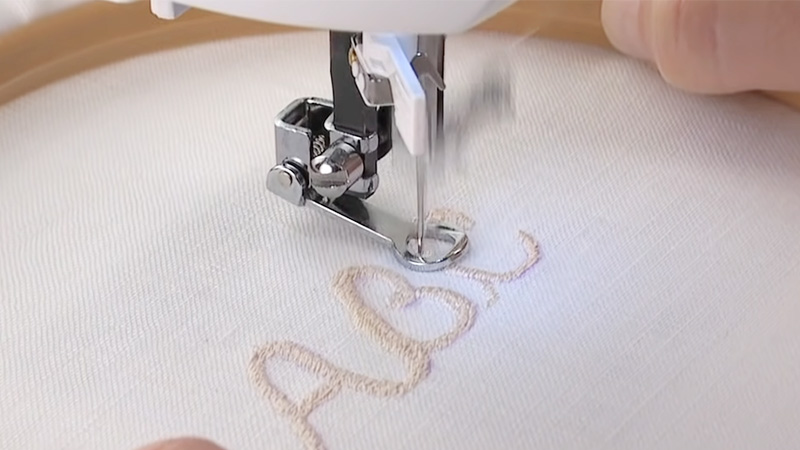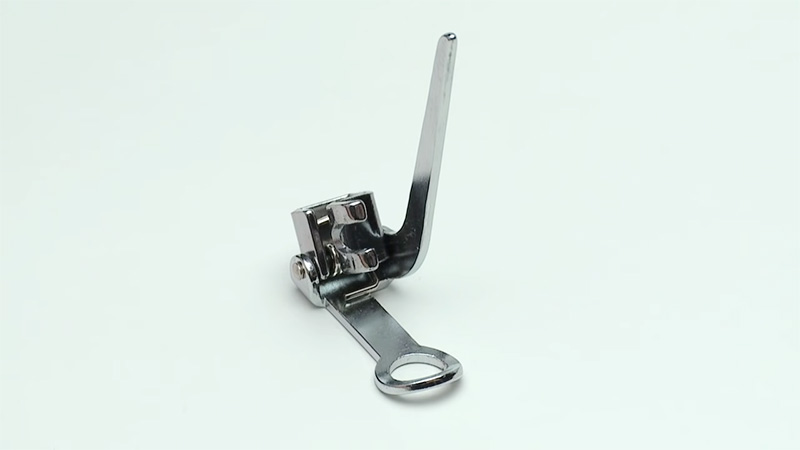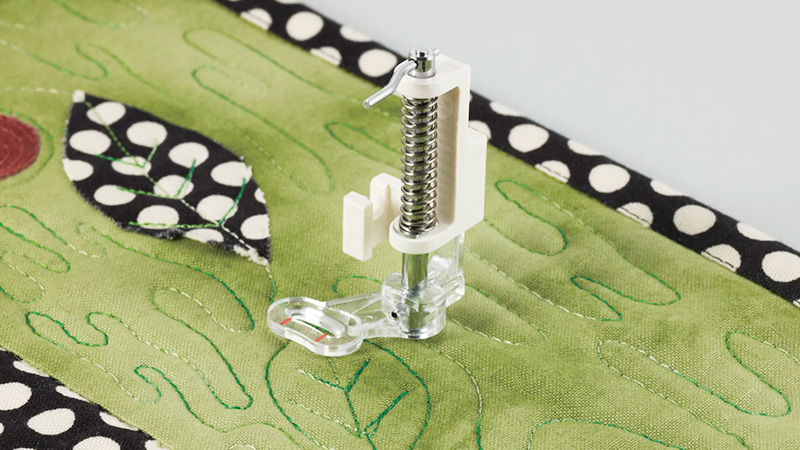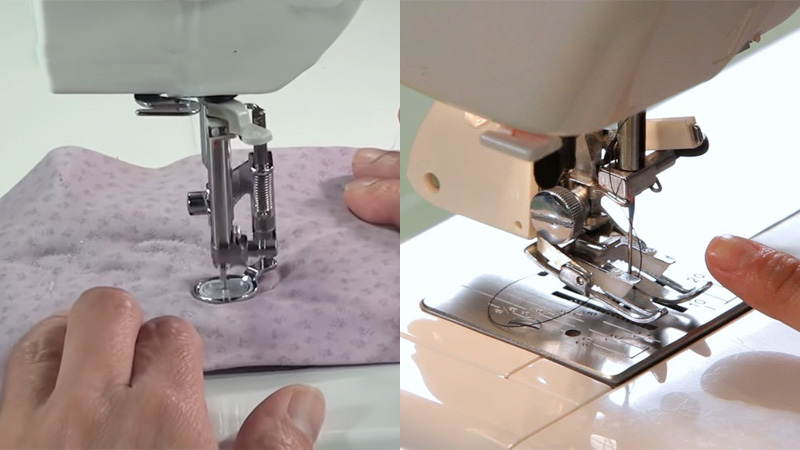A free-motion foot is a powerful tool in the sewing enthusiast’s arsenal, opening up a world of creative possibilities. Whether you’re a quilter, an embroiderer, or a lover of freehand sewing, mastering the use of this presser foot is essential for unleashing your artistic flair.
In this guide on how to use a free-motion foot, we will explore how to use a free-motion foot that allows you to take control of your sewing machine like never before.
From intricate quilting designs to free-motion embroidery and decorative stitching, this foot empowers you to sew with precision and artistic freedom.
As we delve into the methods and practices of free-motion sewing, you’ll discover the key to creating beautiful and unique projects that bear your personal touch.

How To Use A Free Motion Foot?
Using a free-motion foot, also known as a darning foot, is essential for free-motion quilting and other creative sewing techniques where you need to control the fabric’s movement manually.
Here are the simple methods for using a free-motion foot effectively:
Attach the Free Motion Foot
Start by selecting the appropriate free-motion foot compatible with your sewing machine model. Attach it securely to the presser foot holder according to your machine’s instructions.
Lower the Feed Dogs
Most free-motion quilting requires you to lower or disengage the feed dogs (the teeth that usually move the fabric). Consult your sewing machine’s manual to learn how to do this.
Select the Appropriate Needle and Thread
Choose a needle appropriate for your fabric and project. For quilting, a size 90/14 or 75/11 needle is often suitable. Select a quilting or embroidery thread in a color that complements your project.
Install a Quilting or Embroidery Hoop (Optional)
While not always necessary, using a quilting or embroidery hoop can help stabilize your fabric, making it easier to maneuver during free-motion work.
Adjust the Tension and Stitch Length
Set your machine’s tension and stitch length to accommodate free-motion work. Typically, a lower tension and a shorter stitch length are preferred, but adjustments may vary depending on your fabric and project.
Practice on Scrap Fabric
Before working on your actual project, practice on a scrap piece of fabric to get a feel for controlling the fabric’s movement and to fine-tune your machine’s settings.
Start Stitching and Move the Fabric Freely
Begin sewing with a few manual stitches to secure your thread. Then, with the free-motion foot engaged, move the fabric freely in any direction to create your desired design or quilting pattern. Remember to maintain a consistent speed and practice even stitches.
Using a free-motion foot requires practice and patience, but it opens up a world of creative possibilities for quilting, freehand embroidery, and decorative stitching.
By mastering these methods and honing your control over the fabric’s movement, you can achieve beautiful and personalized results in your sewing projects.
Tools Needed To Use A Free Motion Foot

Using a free-motion foot for sewing and quilting involves specific tools and accessories to ensure a smooth and productive experience.
Here are the essential tools needed for using a free-motion foot:
Free Motion Foot (Darning Foot)
The free-motion foot, also known as a darning foot, is the central tool for free-motion sewing. It allows you to control the fabric’s movement while the feed dogs are lowered, giving you the freedom to create intricate designs and quilting patterns.
Quilting or Embroidery Thread
Choose a high-quality quilting or embroidery thread that complements your project. These threads are designed to withstand the rigors of free-motion sewing and provide excellent stitch quality.
Needles Suitable for Free Motion Work
Select needles appropriate for free-motion sewing. Quilting needles or embroidery needles are often recommended, as they have a tapered point and can handle the demands of stitching through multiple layers of fabric and batting.
Quilting or Embroidery Hoop (Optional)
While not mandatory, a quilting or embroidery hoop can help stabilize the fabric and provide better tension control, especially for intricate designs. It’s a helpful tool for maintaining smooth fabric movement.
Sewing Machine with Drop Feed Dogs Feature
Ensure your sewing machine has a drop feed dogs feature or the ability to disengage the feed dogs. This is essential for free motion work since it allows you to move the fabric freely under the needle.
Machine Extension Table or Quilting Table (Optional)
A sewing machine extension table or quilting table provides additional workspace and support for larger quilting projects. It helps manage the fabric’s weight and reduces drag, making free-motion quilting more manageable.
Marking Tools
Marking tools like fabric markers or chalk are essential for creating guidelines and design elements on your fabric before free-motion sewing. These markings serve as reference points for your stitching patterns.
With these essential tools and accessories, you’ll be well-equipped to tackle a wide range of free-motion sewing and quilting projects. They not only enhance your control over the fabric but also contribute to the overall quality and precision of your stitching.
How Do You Adjust Your Sewing Machine Settings For Free Motion Quilting?

Adjusting your sewing machine settings for free-motion quilting is crucial to achieving precise and beautiful results.
Here are the tips:
Lower the Feed Dogs
Start by lowering or disengaging the feed dogs, the teeth that usually move the fabric forward. This allows you to control the fabric’s movement manually.
Consult your sewing machine’s manual for instructions on how to lower the feed dogs, as the process may vary between machines.
Install a Free Motion or Darning Foot
Attach a free motion or darning foot to your sewing machine. This foot is designed with an open toe and spring action to allow for easy movement of the fabric in any direction. Ensure it’s securely attached before starting your quilting project.
Adjust the Tension
Lower the tension on your sewing machine to prevent the thread from puckering or creating loops on the fabric’s surface. A lower tension setting (around 0 to 2) is generally recommended for free-motion quilting.
Select the Right Needle
Choose a quilting or embroidery needle suitable for free-motion work. These needles often have a tapered point, allowing them to penetrate multiple layers of fabric and batting smoothly. Ensure the needle is correctly inserted and tightened.
Set the Stitch Length to Zero
Since you’re in control of the fabric movement, set the stitch length to zero or the shortest setting on your machine. This prevents the machine from advancing the fabric while you’re quilting.
Thread Your Machine Properly
Ensure the thread is correctly threaded through the machine, following your machine’s threading diagram. Proper threading helps prevent thread tension issues and ensures smooth stitching.
Practice on Scrap Fabric
Before working on your quilting project, practice on a scrap piece of fabric. This allows you to get a feel for the machine’s settings and practice your free-motion quilting techniques. It’s an excellent way to refine your control and stitch quality.
By following these tips and making the necessary adjustments to your sewing machine settings, you’ll be well-prepared to tackle free-motion quilting projects with confidence and precision.
With practice, you can create stunning quilting designs and add your unique touch to your quilted creations.
What Is The Difference Between A Free-Motion Foot And A Walking Foot?

The free-motion foot and the walking foot are two distinct sewing machine presser feet, each designed for specific sewing tasks.
Here are the key differences between them:
Function
- Free Motion Foot: The free-motion foot, also known as a darning foot, is used for tasks like freehand quilting, embroidery, and free-motion sewing. It allows you to manually control the fabric’s movement, creating intricate designs.
- Walking Foot: The walking foot is designed for tasks where even fabric feeding is essential, such as sewing multiple layers of fabric, quilting with multiple layers of batting, and working with slippery or stretchy fabrics.
Presser Foot Design
- Free Motion Foot: The free-motion foot has an open-toe design with a spring that hovers over the fabric. This allows the fabric to move freely in all directions.
- Walking Foot: The walking foot features a set of feed dogs on the foot itself, in addition to the ones on the machine. These feed dogs work together to feed the fabric through the machine.
Feed Dogs Engagement:
- Free Motion Foot: When using a free-motion foot, you lower or disengage the machine’s feed dogs to allow manual fabric control.
- Walking Foot: The walking foot works in conjunction with the machine’s feed dogs, ensuring that both upper and lower layers of fabric are fed evenly.
Applications
- Free Motion Foot: It is primarily used for creative applications like freehand quilting, free-motion embroidery, and decorative stitching, where precise control over fabric movement is essential.
- Walking Foot: Ideal for tasks that require precise alignment and even stitching, such as quilting, sewing bulky or multiple layers, and attaching bindings.
Stitch Types
- Free Motion Foot: Suitable for straight stitching, zigzag stitching, and various decorative stitches where the fabric movement needs to be controlled manually.
- Walking Foot: Works well with straight stitches and zigzag stitches but excels in maintaining even stitch length and alignment for a wide range of sewing tasks.
Versatility
- Free Motion Foot: Limited to creative and artistic applications where you want to break free from the constraints of the machine’s feed dogs.
- Walking Foot: Versatile and essential for many sewing tasks, making it a staple for quilting and working with challenging fabrics.
Thread Tension
- Free Motion Foot: You typically lower the thread tension when using a free-motion foot to prevent puckering and allow for smooth fabric movement.
- Walking Foot: The thread tension settings remain closer to standard settings since the walking foot works in conjunction with the machine’s feed dogs to maintain even tension.
Understanding the differences between these two presser feet is essential for choosing the right one for your sewing project.
Whether you need the creative freedom of free-motion stitching or the precision of even feeding with a walking foot, having both in your sewing toolkit can enhance your versatility and capabilities.
FAQs
What is a free-motion foot, and how does it differ from a regular presser foot?
A free-motion foot, also known as a darning foot, is a sewing machine attachment designed for creative stitching.
Unlike a regular presser foot, it has an open-toe design and allows you to manually control the fabric’s movement. It’s ideal for freehand quilting, embroidery, and decorative stitching.
How do I install a free-motion foot on my sewing machine?
Installing a free-motion foot is straightforward. First, raise the presser foot lever, remove the regular presser foot, and then attach the free-motion foot by securing it to the presser foot holder. Ensure it’s properly fitted before starting your project.
Do I need to adjust my sewing machine settings when using a free-motion foot?
Yes, you’ll need to make several adjustments. Lower the feed dogs, select a suitable needle, reduce the tension, set the stitch length to zero, and practice on scrap fabric to get the right feel for fabric movement.
Can I use a free-motion foot for quilting and embroidery projects?
Absolutely! A free-motion foot is perfect for quilting, allowing you to create intricate designs and patterns. It’s also excellent for free-motion embroidery, giving you the control to stitch detailed and artistic designs.
What tips can enhance my free-motion foot technique?
To improve your free motion sewing, practice regularly, maintain even stitching speed, use appropriate thread and needles, secure your fabric layers with basting stitches or an embroidery hoop, and experiment with different designs and motifs to develop your creativity and skill.
Conclusion
In the realm of sewing, the free-motion foot is a bridge between craftsmanship and creativity, offering a blank canvas upon which your imagination can run wild. As we conclude our exploration of how to use a free-motion foot, it’s evident that this versatile presser foot transcends ordinary sewing.
With its ability to disengage feed dogs and give you control over fabric movement, it’s a gateway to artistic expression.
Whether you’re adding intricate quilting to your latest creation or crafting freehand embroidery designs, the free-motion foot allows you to bring your visions to life with precision and style.
So, embrace the artistry of free motion sewing, practice your technique, and watch as your sewing projects transform into works of art, uniquely yours.
Leave a Reply